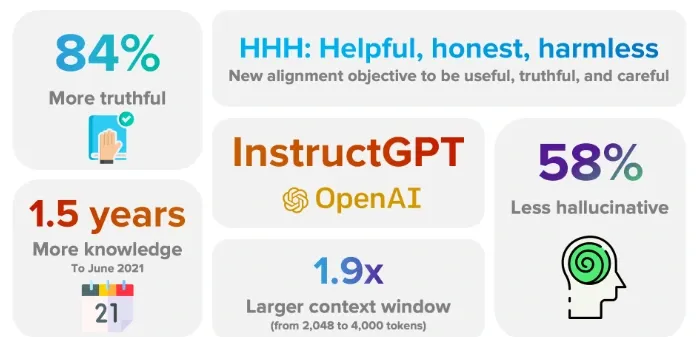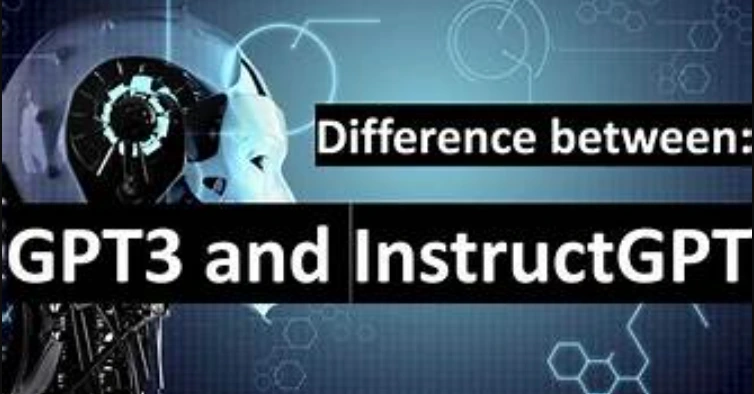Unveiling InstructGPT: A Powerful Language Model by OpenAI

In the fast-paced world of natural language processing, InstructGPT has emerged as a game-changing innovation. Developed by OpenAI, this advanced language model has a unique capability: understanding and executing specific instructions with remarkable precision.
In this comprehensive blog, we'll delve into the intricacies of InstructGPT, explore its practical applications, and distinguish it from its sibling model, ChatGPT.
Table of Contents
- Understanding InstructGPT
- Accessing InstructGPT
- How to Make the Most of InstructGPT?
- Real-World Applications
- Difference Between ChatGPT vs InstructGPT
- Conclusion
- Frequently Asked Questions

Understanding InstructGPT
InstructGPT's Purpose: InstructGPT is a cutting-edge computer program engineered to excel in understanding and executing specific instructions, making it a valuable tool for a wide range of applications.
OpenAI has meticulously refined this model through a combination of reinforcement learning and human feedback, ensuring that its responses closely align with human intentions.
Model Sizes: InstructGPT is available in three different model sizes, offering varying levels of complexity and sophistication: 1.3 billion parameters, 6 billion parameters, and 175 billion parameters. This flexibility enables users to choose the model size that best suits their specific needs.
Accessing InstructGPT
While InstructGPT is a powerful tool, it's important to note that access to this model via the OpenAI API is not typically free. Users can leverage its capabilities for various language modeling tasks, but it comes with associated costs based on API usage.
The Inner Workings of InstructGPT

InstructGPT operates through a sophisticated two-step process:
1. Instruction Parsing: During this initial phase, InstructGPT utilizes advanced natural language processing techniques to comprehensively understand and extract essential information from provided instructions.
This phase involves identifying the intent behind the instructions, grasping the context in which they are given, and discerning any specific parameters specified within the instructions.
2. Text Generation: After successfully parsing the instructions, InstructGPT leverages its extensive pre-trained knowledge to generate text that aligns seamlessly with the provided instructions.
This process involves the model's proficiency in grammar, vocabulary, and contextual coherence. The result is text that is not only factually accurate but also contextually appropriate, maintaining a logical flow and consistency with the given instructions.
The Transformer Architecture: InstructGPT is built on the powerful Transformer architecture, which was originally introduced by Google researchers. This architecture consists of multiple layers, each incorporating a self-attention mechanism and a feed-forward neural network.
This design allows the model to assess the importance of different elements within the input data when making predictions.

Few-Shot Learning: InstructGPT has the remarkable ability to perform new tasks with a minimal number of examples, making it highly adaptable to various scenarios. This means it doesn't require a large labeled dataset with numerous examples for each specific task.
How to Make the Most of InstructGPT?
Using InstructGPT effectively via the OpenAI API involves several key steps:
1. Access the OpenAI API: To begin, you must access the OpenAI API by signing up and obtaining the necessary API key or credentials. This typically involves registering your application or project with OpenAI to gain access to the model.
2. Define Your Task and Instructions: Before interacting with InstructGPT, it's crucial to have a clear understanding of the task you want to accomplish and the specific instructions you want to provide to the model. It excels in scenarios where you can give explicit and detailed instructions for the model to follow.
3. Make API Calls: Using your preferred programming language, you'll create API calls to interact with InstructGPT. You send your instructions as input to the model, and it will generate relevant output based on those instructions.
4. Analyze and Refine Output: Once you receive responses from InstructGPT, it's essential to carefully review the generated output. Analyze whether the model's responses align with your intended task and the instructions you provided.
If the output is not satisfactory or doesn't meet your needs, you can refine your instructions and make subsequent API calls to achieve better results. Iterative refinement may be necessary to fine-tune the model's responses.
5. Adhere to API Usage Guidelines: To maintain ethical and responsible usage of the model, it's vital to adhere to OpenAI's API Usage Guidelines and API Terms of Use. OpenAI reviews use cases before allowing models to be used in production applications and may revoke access in the event of violations or misuse.
Real-World Applications
InstructGPT's ability to generate text based on specific instructions indeed opens up a wide range of practical applications across various domains:

1. Technical Documentation: InstructGPT can be a valuable tool for generating technical documentation efficiently. For instance, you can instruct the model to produce a user manual for a software product, specifying the required sections, content structure, and the use of technical jargon or plain language.
This application is particularly useful for software companies and developers looking to streamline the creation of comprehensive and standardized technical documentation.
2. Code Comments and Annotations: In software development, code comments and annotations are essential for code readability and maintainability. It can be instructed to generate comments for specific functions or code sections, providing context, explanations, and usage examples.
Software developers can use InstructGPT to automate the generation of code documentation, reducing the time spent on writing comments and ensuring codebases remain well-documented.
3. User Support and Troubleshooting: It can serve as a virtual support agent by providing instant responses to user queries or issues. It can be instructed with common user questions or specific error messages, generating relevant troubleshooting steps or solutions.
Companies can deploy InstructGPT as a part of their customer support system, offering 24/7 assistance, reducing response times, and improving the overall user experience.
4. Content Generation: Content creation is a versatile application for InstructGPT. Whether it's blog posts, articles, marketing copy, or product descriptions, the model can be instructed on the desired writing style, tone, and topic.
Content creators, marketers, and businesses can use it to produce engaging and high-quality content efficiently. It can be especially helpful for generating content at scale, such as product descriptions for e-commerce websites.
5. Multiple Language Translation: It possesses the capability to perform language translation, facilitating businesses in the efficient and accurate conversion of documents and content into various languages. This functionality streamlines the localization process, making it easier to reach a global audience.
6. Data Cleaning and Data Entry Automation: InstructGPT has the potential to revolutionize data-related tasks by automating data entry and cleaning processes. This translates to a significant reduction in errors, freeing up valuable time and resources for businesses. It ensures that data remains accurate and organized.
7. Automated Customer Service: It can be harnessed for automating customer service interactions. It has the ability to generate automated responses to customer queries, thereby alleviating the workload of human customer service agents and enhancing response times. This results in improved customer satisfaction and operational efficiency.
In all these applications, InstructGPT's strength lies in its ability to generate text that adheres to specific guidelines and instructions, saving time and effort while maintaining quality and consistency.
Difference Between ChatGPT vs InstructGPT

InstructGPT and ChatGPT, both developed by OpenAI, are distinct language models with differences in training, intended use, and capabilities:
1. Training Data: InstructGPT is trained to excel in tasks
that involve specific instructions, while ChatGPT is optimized for generating human-like responses in interactive conversations.
2. Purpose: InstructGPT is designed for structured, instruction-based tasks, while ChatGPT is ideal for chatbots, virtual assistants, and general conversational interactions.
3. Fine-Tuning: InstructGPT typically undergoes fine-tuning on specific datasets tailored to perform particular tasks or within specific domains, while ChatGPT starts from a more generalized conversational model that can then be fine-tuned for specific use cases.
4. Language Model: Both models utilize the Transformer architecture, but InstructGPT is fine-tuned for precision-based tasks, and ChatGPT is optimized for conversational data.
5. Output: InstructGPT generates content relevant to specific instructions, while ChatGPT simulates human-like interactions in conversations.
While both InstructGPT and ChatGPT are language models based on the Transformer architecture, they differ in their training, purpose, and output, making them suitable for distinct applications and use cases.
Conclusion
InstructGPT represents a significant leap forward in the field of natural language processing. Its meticulous instruction parsing and contextually relevant text generation make it a formidable tool for precision-based tasks. Built on the robust Transformer architecture and fine-tuned for specific tasks, it has the potential to enhance efficiency and effectiveness across various domains.
As the landscape of natural language processing continues to evolve, InstructGPT stands as a powerful tool that opens doors to a myriad of practical applications and innovations.
Frequently Asked Questions
- What is instructgpt & how does it work?
InstructGPT, derived from GPT-3 through fine-tuning, underwent training using a dataset comprising human-generated instructions. This specialized training empowers InstructGPT with improved comprehension of queries, enabling it to produce outputs that are more precise and contextually relevant. Its capability extends to interpreting and executing instructions provided in everyday language.
2. Does instructgpt follow instruction in other languages?
Yes, instructgpt follow instruction in other languages also. In specific scenario, a carefully selected prompt demonstrates the instruction-following capability of the models in various languages, showcasing InstructGPT's ability to adhere to instructions while primarily generating text in English, even in the Finnish example.
Additionally, random text samples from both the GPT-3 175B and InstructGPT 175B models are provided for comparison.
3. Is InstructGPT better than gpt-3?
The primary language models now available on our API are InstructGPT, which outperform GPT-3 in comprehending and executing English instructions. To describe the moon landing to a 6-year-old, think of astronauts embarking on a very long journey in a special spaceship to reach and explore the moon, similar to brave adventurers in real life.
Explaining gravity to a 6-year-old is like describing a special force that works like magic, pulling everything towards the ground, much like how a magnet attracts certain things. This force keeps us firmly on the ground and causes objects to drop down when we release them. For such instructions, as evident, InstructGPT outperforms GPT-3.

Simplify Your Data Annotation Workflow With Proven Strategies
.png)


